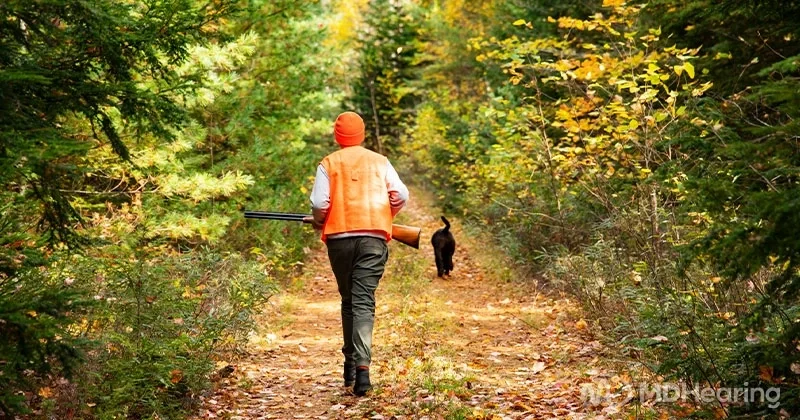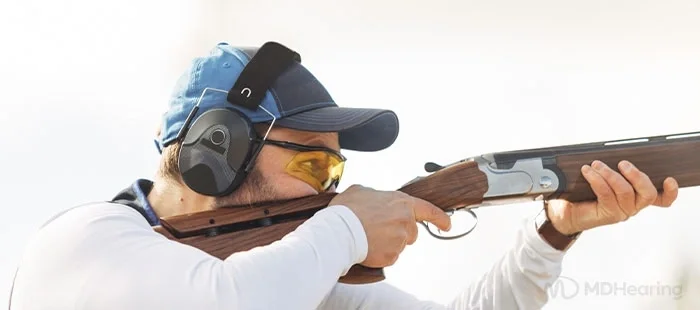Hunting season is upon us. For many people, that means early mornings, camo attire, and long days spent out in the woods. There’s nothing quite like the tranquility and focus that comes with waiting for that perfect opportunity.
Between the excitement and the quiet, hearing safety can easily slip one’s mind. Preparing your hunting ear protection ahead of time will help you avoid unnecessary hearing loss while enjoying the great outdoors.
Firearms, Decibel Levels, and Hearing Loss
When most people think of hearing loss, they picture aging or exposure to loud environments, like concerts or construction sites, as the cause. However, noise-induced hearing loss (NIHL) can happen from a single loud sound—not just long-term exposure. The CDC notes that prolonged exposure to sounds above 85 decibels (dB) can cause permanent hearing loss, while short bursts above 120 dB can damage your ears instantly.
Unfortunately for hunters, nearly all firearms exceed safe listening levels. The American Speech-Language-Hearing Association (ASHA) reports that small-caliber rifles, shotguns, and pistols can produce up to 140 dB, while high-caliber rifles can reach 175 dB or higher. All of these types of firearms can cause permanent damage with just one shot.
Even with suppressors, the American Suppressor Association explains that most firearms still generate over 130 dB—well above safe limits. Shooting in enclosed spaces, like a hunting blind, amplifies the sound through reverberation, further increasing the risk of immediate and permanent hearing loss.
How Gunfire Damages Your Hearing
When a gun fires, the intense sound wave travels through the ear canal to the cochlea—the sensitive inner-ear structure that converts vibrations into electrical signals for the brain to understand. Loud gunfire can instantly damage the cochlea's delicate hair cells, which are essential for hearing. As the Cleveland Clinic explains, “Once damaged, these cells can’t heal or regenerate (grow back).”
Because of this, exposure to gunfire without protection can result in immediate and permanent hearing loss. Symptoms like ringing in the ear (tinnitus) or muffled hearing after hunting are early warning signs of this damage.
Hearing Loss Among Hunters is Common
Researchers at the University of Wisconsin revealed how prevalent the problem of hearing loss is among hunters. The study found that those who hunted on a regular basis were much more likely to experience high-frequency hearing loss. Even more alarming, 95 percent of the hunters said they did not wear hunting ear protection at all in the past year.
The issue extends beyond recreational hunting. The CDC recently reported that approximately 14% of workers in the Agriculture, Forestry, Fishing, and Hunting sector experience hearing difficulty, 13% have tinnitus, and nearly 75% of those exposed to loud noise say they don’t use hearing protection.
These statistics highlight a dangerous trend: unprotected exposure to gunfire and other loud occupational noises is leading to irreversible hearing damage across all age groups. To combat this, experts recommend using hearing protection consistently and scheduling hearing checks at least every three years—or sooner if any issues arise. Taking these steps can help preserve your hearing health for the long term.
Hunting Ear Protection From Firearm Noise
It’s extremely important to use hearing protection while using a firearm. If you don’t, you can suffer severe hearing loss with just one shot—and once your hearing is gone, it’s gone for good. Hearing cannot be restored, only assisted with hearing aids.
Protecting your ears before you pull the trigger will help you stay safe and preserve your ability to enjoy the sounds of nature for years to come. There are two main types of hearing protection devices (HPDs): passive and active.
Passive Protection
Passive protection—such as foam earplugs or non-electronic earmuffs—muffles noise by physically blocking sound waves from entering the ear canal. It’s affordable, effective, and easy to replace—but it can also block out too much environmental sound, making it harder to detect movement or communicate while hunting. Thus, this type of protection is best for shooting ranges, where awareness of your surroundings isn’t as crucial.
Active Protection
Active (electronic) protection—such as electronic earmuffs or earbuds—uses technology to block harmful noise while still allowing you to hear what's happening around you. These devices use built-in microphones to pick up and amplify quiet, natural sounds (like conversation, movement, or animal calls) while automatically lowering sudden loud noises such as gunfire.
This type of technology helps you to remain alert and connected to your environment, which can also help prevent miscommunication or unsafe shots in group hunting settings, while still shielding your ears from harmful noise levels. Because active protection adapts to different sound levels, it’s especially useful when you need both situational awareness and reliable hearing safety in the field.
Have You Experienced Hearing Loss? Get Tested
If you’ve ever noticed ringing, muffled hearing, or difficulty understanding others after shooting, it may be an early sign of hearing damage. MDHearing offers a quick, free online hearing test to check your hearing in just a few minutes from home.
Early detection can help you identify changes before they worsen—and determine if hearing aids could help you.
Whether you hunt a few times a year or every weekend, protecting and monitoring your hearing ensures you can keep enjoying the sounds of nature, your surroundings, and the people you share the sport with.
Test your hearing online for free today.
TAKE ONLINE HEARING TEST

